In mainland China, the festivities surrounding the Chinese New Year are intense and raucous, but here in Nicoya it is a much quieter affair. On Friday, February 8th, I gathered with about 70 people for the celebration of Chinese New Year at El Presidente Restaurant, which was closed to the public for the special event. Curiosity mounted as waiters brought out one course after another, eight in total, each one a new mix of flavors and aromas. According to the Chinese lunar calendar, this year began on Sunday, February 10th.

Photos by Pinar Istek
Miguel Chan Achiu, 88, poses for a portrait in his kitchen after eating lunch with his wife Delia Cheng Yuong, 73, Friday afternoon, Feb. 15, 2013 in Nicoya. According to their daughter Xenia Chan, traditional Chinese people tend to have their homes attached to their businesses, which is also the case for her parents. While the front part of the building accommodates the family store, the old couple still lives right behind the store.
Dressed in a white oriental dress with pink and black flowers printed on it, Tatiana Yockchan, secretary of the Chinese Association of Nicoya (Asociacion China de Nicoya), explained that this year, the year of the snake, is a year of possibilities for dramatic, destabilizing changes.
The dinner is one of two main social cultural events hosted annually by the Chinese Association of Nicoya), which is one of two Chinese associations registered in the Nicoya area. The other is the Chinese Association of the Peninsula of Nicoya (Asociacion China de la Peninsula de Nicoya). The presidents of the two associations are first cousins.
In fact, most of the Chinese who settled in Nicoya are somehow related to each other. In general, they come from the province of Canton, in south-central mainland China. Members of the Chinese associations estimate that there are between 30 and 50 first-generation Chinese immigrants still living in the Nicoya area, and with their descendents they now form a community of 300 to 400 Chinese Ticos.
The stories of many of the Chinese families who call Costa Rica home are rooted in an era of political turmoil, natural disaster and the resulting poverty: motives for journeying to the other side of the world to adapt to a new land and a new culture, creating ties that are influencing the nation as a whole (see story “Coming to the Americas from China: One Family’s Story ).
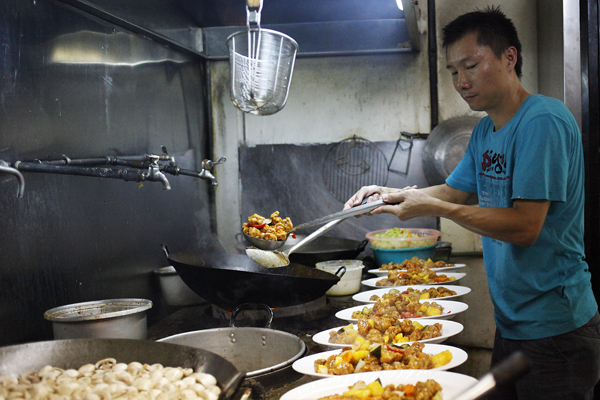
A cook at El President Chinese Restaurant in Nicoya serves sweet and sour chicken for the guests of the Chinese New Year dinner Feb. 8, 2013.
Chinese Influence in Costa Rica
The president of the Chinese Association of Nicoya is 72-year-old Juan Edwin “Pino” Yockchan Sanchun. Pino affirmed, “I consider myself proudly Costa Rican because of the democracy and proud to have Chinese origin.”
Pino’s son, Juan Edwin Yockchan Mora, related that both he and his father were born here in Costa Rica. It was his grandfather (Pino’s father), Luis Antonio Yockchan Chacon, who immigrated in 1910 to work in the mines in Abangares because of the extreme poverty in China at the time. He already had an uncle here. In time, his grandfather married a woman who was born in Costa Rica of Chinese parents and started a family; but he said all his uncles married Costa Rican women.
Pino only speaks Spanish. However, his father, whom he says was the first Chinese person to settle in Nicoya, did instill in him Chinese values, such as stressing the importance of getting a higher education Although he himself worked in such businesses as a shoe store, a motorcycle distributor and currently owns a hotel, he pointed out that most third-generation Chinese Ticos have university educations and are making a mark on Costa Rican society as doctors, lawyers, orthodontists and politicians. One, Franklin Ramón Chang Díaz, who was born in San Jose, is even an astronaut now.
Pino was invited as a special guest to the inauguration of the Chinese neighborhood in San Jose in January. Although he said the recognition of Chinese culture is nice, he doesn’t consider it a real Chinese neighborhood since it is just an area that many Chinese happened to invest in. Ideally, he said, to create a Chinese neighborhood, an undeveloped area should be found and the neighborhood should be built with authentic Chinese architecture.
While the Chinese Association of Nicoya promotes social and cultural ties among the Chinese community in the city of Nicoya, the Chinese Association of the Peninsula of Nicoya (ACHIPEN) has worked to unite Chinese across the peninsula with a sense of moral obligation and activism. One issue for them is the maintenance of the bridge donated by Taiwan to create a direct route between the Nicoya Peninsula and San Jose. The Puente de Amistad was inaugurated on April 10, 2003 with a cost of $27,000,000, and since then, according to Ligia Quiroz Sanchun, president of ACHIPEN, has not been maintained. She said that when the bridge was inaugurated, they were told by Taiwan that maintenance would need to be done every two years to the submerged columns and the aerial part of the bridge should be repainted annually. Because of this, in 2009 ACHIPEN denounced the deterioration and met with representatives of municipalities of Nicoya and Cañas to request government intervention.
ACHIPEN also worked with Legislator Francisco Sanchun Moran to officially declare the first Monday in October as Chinese Culture Day (El Dia de la Cultura China) in order to recognize Chinese contributions to Costa Rica. This is the other Chinese holiday celebrated each year by the Chinese associations, in addition to Chinese New Year. Ligia said that in October, information about Chinese culture is given in the schools, and they host discussions on the radio about Chinese traditions, show movies that promote Chinese values such as respect for the elderly and share traditional Chinese food.
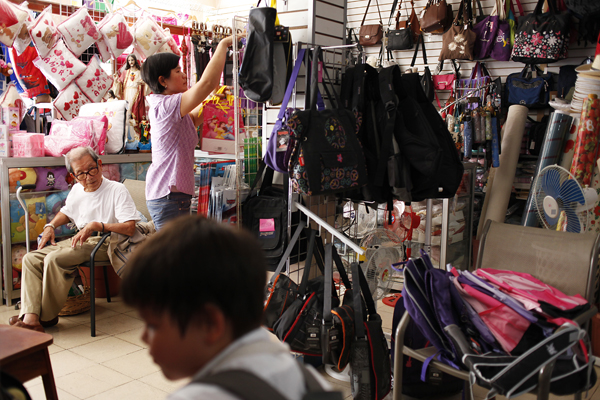
Miguel Chan Achiu, 88, left, sits at the front of his store while his daughter, Paz Andrea Chan, organizes the items and his grandson, Jose Miguel Alfaro Chan, 10, waits to go to school Friday morning, Feb. 15, 2013 in Nicoya.
Chinese Values and Culinary Culture
One afternoon in late December, Ligia invited me to her home. As we sit in her living room with juice and cookies, 70-year-old Ligia speaks passionately of the association and of Chinese culture. In one corner of the living room is a glass case displaying dolls she has collected from around the world, including several from China, and on the opposite side of the room a strand of Chinese fish hangs in a doorway and a large painting of a cowboy riding across the fields of Guanacaste is displayed on the wall. She painted it herself.
“I have two loves and two hearts,” she remarked, explaining that she loves the culture, customs and peace of Guanacaste that she represents in her paintings, and she also loves Chinese culture and values that she promotes through her work with ACHIPEN.
Ligia is a third-generation Chinese Tica. Her grandfather, Andres Sanchun, arrived in Puntarenas in 1895 and then moved to Nicoya in 1900, where he opened the first pulperia in the city. They adapted in Costa Rica to create a hybrid culture. “It was a house where they ate Chinese food and corn from Guanacaste,” Ligia explained.
Although she understood when her grandparents spoke in Cantonese, she didn’t really learn the language. However, her only daughter, Natalia Perez Quiros, went to the University of Shanghai to study, where she learned to speak Mandarin and write in Chinese as well. It was Natalia who first reconnected with relatives in mainland China, and the relatives later called for Ligia when her older uncle was sick and wanted to meet her. “Mama, you have to go because it’s the older uncle and he is calling you,” her daughter told her.
Up until then, although Ligia had been instilled with respect for her elders, she didn’t fully understand the depths of the high standing that the elderly have in Chinese culture. When she arrived in China in 2005, her relatives received her with so much affection and respect that she was overwhelmed. “I am the firstborn of the firstborn of my grandparents,” she explained. That makes her the current head of her family clan, so all of the relatives have to consult her about everything, respectfully calling her “older sister.”
Food is another hallmark of Chinese culture. Ligia explained that for the Chinese, the flavor is not the only factor in good food. Texture is equally important. That is one reason why shark fins are considered a delicacy by many Chinese. Before shark finning was prohibited in Costa Rica, Ligia’s father used to buy fins from local fisherman and prepared them in soup. The fin itself doesn’t taste like anything, she said, but the texture is like gelatin.
Two other members of the Chinese Association of Nicoya are able to meet with me before the Chinese New Year dinner to share more insight into the Chinese community in Nicoya. We sit at a table in Cafe Daniela on the main street of Nicoya with the cafe’s owner, Danilo Chong Kan and with Enrique Choy. Danilo, a third-generation Chinese Tico, is first vocal of the association and Pino refers to him as his “right hand.” He is middle-aged with a round face and an easy sense of humor. He says he is not Chinese; he is Guanacastecan.
“I have never been to China, but when I smell Chinese food I am very Chinese and when I listen to Chinese music I feel nostalgia,” he affirmed.
The Chinese eat anything that moves or grows,” he explains with a large smile. Though he personally doesn’t like eating shark fins, he explained that they are believed to be an aphrodisiac in Chinese tradition, much as the Rhino horn used to be. “Rhinos were saved by Viagra” he jokes. Hopefully sharks will somehow be saved too, but they are still much in demand in Taiwan. Danilo said shark finning used to be big business in Puntarenas before it was prohibited, and affirmed that as long as there is money to be made, the practice will continue. Personally, though, he said his favourite food is gallo pinto with chicharron (rice and beans with pork rinds).
Enrique, secretary of the association and former director of the high school in Nicoya, is 76 years old and was brought to Costa Rica as a newborn baby. He is thin and fair skinned, wearing a blue baseball cap. His cane is propped against his knee.
First-generation Chinese immigrants generally married other Chinese, often times because they were obligated to do so, according to Enrique. However, by the third generation they intermarried with Costa Ricans or other nationalities. For example, Ligia is married to a Peruvian man that she met when she was studying at university. Danilo is married to a Tica, although after they married he found out she is 1/8 Chinese. Danilo light-heartedly explained that they started marrying non-Chinese because in general other Chinese in the area are relatives and because the Costa Rican women are very lovely. However, he noted that in other countries this has not been the case. For example, in Panama, the majority of Chinese immigrants have remained clustered in Panama City where they have their own schools and marry within the Chinese community. In Costa Rica, however, Danilo pointed out that the Chinese are more dispersed around the country, with large groups of Chinese in Limon, Puntarenas and San Jose. He also noted that in general they have adapted local religion, many practicing the Catholic faith.
Initially, the Chinese who immigrated to Costa Rica had a basic education and they tended to work as merchants, selling things like food, clothing and shoes. With the value the Chinese place on family, honor, work and education, however, about 90% of the third generation of Chinese Ticos are educated professionals who speak more Spanish and English than Chinese. In fact, he said the Chinese who work in Chinatown areas in cities like New York or San Francisco in the United States tend to learn Spanish in order to sell items to people of Chinese descent who visit from other Latin American countries and don’t know how to speak Chinese.
This is the case with some of the third-generation Chinese community in Nicoya, who have never learned Chinese. Those who have learned it speak Cantonese, although a few of them have learned Mandarin Chinese when studying since it is considered the main secular language. One phrase was said in Chinese during the introductory speech at the Chinese New Year dinner made by Tatiana Yockchan, and she said she had to practice how to say it. As I sat with them at the restaurant, I hardly heard anyone speaking Chinese. Most conversations took place in Spanish.
As dinner ended with slices of watermelon for dessert, the raffle began and the group livened up a bit. Once all of the gifts were distributed, the dinner ended as quietly as it began. Family groups stood, gathered their things and left. Pino says that this is the way the Chinese are, and they won’t get together again until the association convenes another social event. Unless there is a wedding or a funeral, that might not be until October, a politically significant month for the Chinese with the start of the Wuchang Uprising on October 10, 1911 and the establishment of the People’s Republic of China on October 1, 1912.
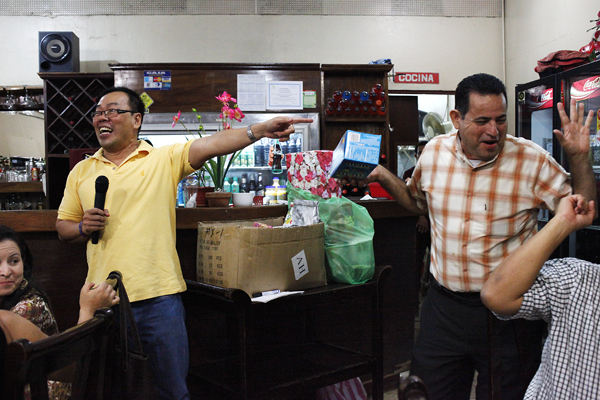
Danilo Chong Kan, left, jokes with Gerardo Atan during the raffle for the Chinese New Year Dinner on Feb. 8, 2013 at El Presidente Chinese Restaurant in Nicoya.
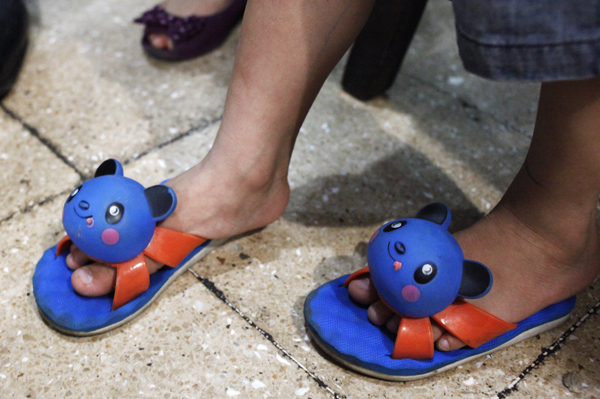

Pino draws the last ticket for the grand prize of the raffle during the Chinese New Year Dinner Feb.8, 2013 at El Presidente Chinese Restaurant in Nicoya.
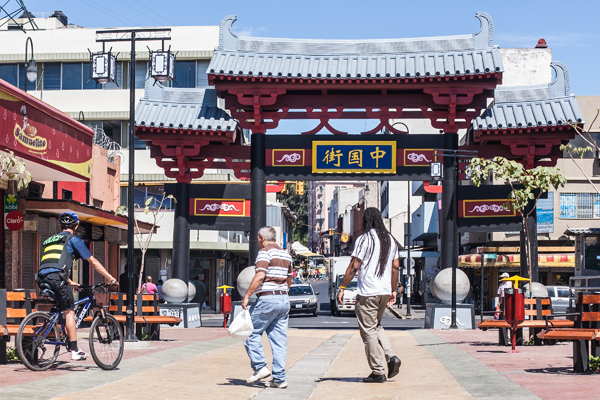
Photo by Giordano Ciampini
China Town in San Jose.
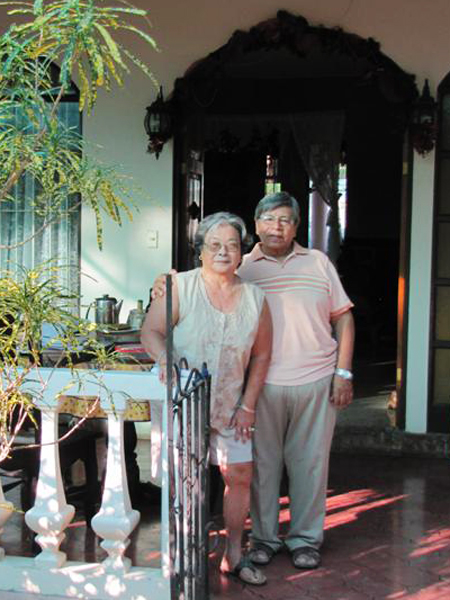
Photo by Arianna McKinney
Ligia Quiroz Sanchun and her Peruvian husband, Dr. Carlos Perez Roman, pose for a portrait in front of their Nicoya. Although first generation Chinese who immigrated to Costa Rica tended to marry Chinese only, by the third generation, Chinese Ticos were already marrying non-Chinese.

Photo courtesy of Ligia Quiroz Sanchun
Isabel Sanchun was the first generation of her family to make Costa Rica her home. Her daughter, Blanca, granddaughter Ligia and great-granddaughter Natalia have all grown up in Nicoya.
 |
| |
More community news
Los Arenales Fiestas Raised Almost $6K for Asphalt
The Fiestas held in Nosara last Saturday March 23 to help raise money for Los Arenales asphalt preparations work collected almost $6000 out of the $28000 that the community need.
MOPT Starts Pavement of Route 160
Pavement is coming for those who live along route 160. Since March 19, machinery from the Ministry of Public Works and Transportation (MOPT) entered the communities with the objective of partially paving 8.5 kilometers.
Community of Los Arenales Organizes Fiesta to Pave Main Road
Even though pavement is arriving to Nosara thanks to an agreement with CONAVI, not all of the costs are covered. In the Los Angeles neighborhood, neighbors need to raise 14 million colones ($28,000) to widen the main street and build curbs and gutters, so they decided to organize a fiesta this Saturday, the 23rd, to collect the funds.
Low Interest in Samara to Have More Police Presence During Easter
On Monday, March 18, the Samara Chamber of Tourism (CASATUR) called a meeting in the community, inviting more than 400 locals, residents and business owners, in order to plan for 20 additional police officers that the Public Force had offered during Easter Week.
New Nosara School Foundation Already Working On The Playground
Some students from Serapio Lopez School in Nosara had to spend the first day of school sitting on the floor of their classroom. Fifth-grader Lara Schussler, 10, said, “It was really sad and uncomfortable.” Ashley Ruiz, 11, also in fifth grade, added that it was hard for them to concentrate on the class while sitting on the floor.
Bureaucracy Delays Process for Ministry of Security to Take Charge of Tourist Police Station Rent
Since last year, the Nosara Security Association has been trying to get the Ministry of Security to take over payments of the rent for the tourist police station in Guiones, but delays in paperwork have held up the process and now the association is almost out of money, once again renewing concerns that the tourist police might have to leave town.
Coming to the Americas from China: One Family’s Story
The wind kicks up the tin roof panels overhead, banging away while we speak. I sit scribbling fervently into my notebook as Xenia Waigui Chan tells me her parents’ peculiar story: How a Tico and Chinese woman got caught up in history and landed in Nicoya.
“American Project” Asada’s Financial State a “disaster”
On February 20, the Playas de Nosara ASADA water board, often referred to as the “American Project” ASADA, held a meeting assembly to let members know how things stand financially and resolved to send two new rate change requests to ARESEP, the Regulatory Authority for Public Services (Autoridad Reguladora de los Servicios Públicos).
Samara’s Library Relocated
Playa Samara’s public library has found a new home. The library is housed and operated by a local non-profit organization, La Asociación CREAR, whose new office is now located opposite Intercultura Language School next to the beach.
Las Olas Condominium Project with New Owner
For more than five years, the unfinished condominium project Las Olas has been an eyesore in Guiones, but that is about to change, as the property has finally been sold and orders have been given to tear the structure down.
Young Ballerinas in Guanacaste Pass International Exam
For the past three years, young ballerinas in Guanacaste have been studying dance in conjunction with the Royal Dance Academy of London, an international institution for dance, and for the past two years they have participated in the annual international ballet exam to receive recognition for having attained a certain level of proficiency such as pre-primary, primary, 1st grade or 2nd grade.
Nosara Asked for More Security on National Television
On Monday, March 4, the Channel 7 news program “Telenoticias” broadcast around the country a 7-minute news item titled “Wave of Thefts in Nosara Generates Anxiety and Insecurity in Neighbors in the Area.”
Telenoticias interviewed locals on case of thief released by judge
Channel 7 Telenoticias sent a news team to Nosara Feb. 26 to report on the local uproar following the release of a burglar caught red-handed inside a house at Playa Pelada, and almost 100 concerned residents appeared at the Casa Tucan during the videotaping to show their outrage.
DMA delivers school supplies in Nosara area
Starting February 28, Del Mar Academy community service committee (CSC) start delivering supplies and clothes to children in need to the schools of Nosara, Santa Marta, Garza, Esperanza, Santa Teresita, Los Angeles and Delicias. |
 |
|
|

